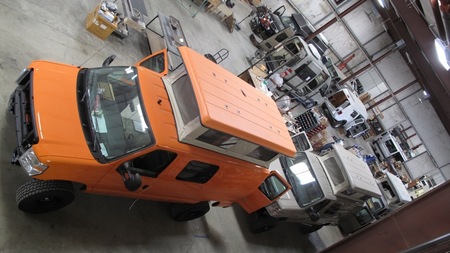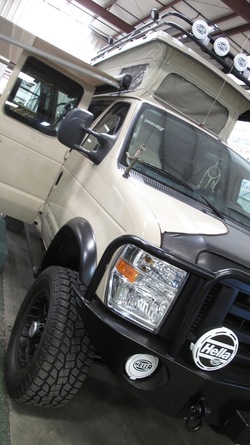Overland Review: Sportsmobile, 50 years strong
 Put the words “conversion” and “van” in the same sentence, and you’re likely to induce imagery of smoked bubble windows and orange shag carpeting. You can almost hear strains of KC and the Sunshine Band. A Sportsmobile is a different beast. More a remanufactured overlanding vehicle on a Ford or Chevy platform than a mere “conversion,” the Sportsmobile is not only a seminal product in its field (2011 marks the company’s 50th anniversary), but can be configured as a heavy-duty, four-wheel-drive, self-contained camper capable of extended journeys in the most remote regions on earth.
Put the words “conversion” and “van” in the same sentence, and you’re likely to induce imagery of smoked bubble windows and orange shag carpeting. You can almost hear strains of KC and the Sunshine Band. A Sportsmobile is a different beast. More a remanufactured overlanding vehicle on a Ford or Chevy platform than a mere “conversion,” the Sportsmobile is not only a seminal product in its field (2011 marks the company’s 50th anniversary), but can be configured as a heavy-duty, four-wheel-drive, self-contained camper capable of extended journeys in the most remote regions on earth.
 On a trip through California last month, we visited Alan Feld, the owner of Sportsmobile West (there are two other divisions as well), in his factory in Fresno, to see the entire process of building the vehicles, from stock van to completed Sportsmobile.
On a trip through California last month, we visited Alan Feld, the owner of Sportsmobile West (there are two other divisions as well), in his factory in Fresno, to see the entire process of building the vehicles, from stock van to completed Sportsmobile.
Once the minimal factory interior is removed from the van, the vast rectangular box is essentially a blank canvas, open to a number of semi-stock interiors or nearly any custom configuration a customer can dream up. If you want to go beyond the basics of stove, fridge, sink, bed, and toilet, you can add flat-screen TVs, captain’s chairs, furnaces and AC units, a shower—the list goes on. The roof can be permanent full-height or a retractable “penthouse.” Everything from counters to plumbing is of first-rate quality.
I enjoyed looking at the well-thought-out interiors, but it was the four-wheel-drive conversion process that most interested me. I’ve seen them done poorly and seen them done well, but rarely have I seen one done as well as here. So seamless is the installation that, looking at a half-finished chassis on a rack, it was impossible to tell where the Ford factory parts left off and the Sportsmobile parts took over—except that the latter were arguably stronger.
 The heavy-duty front axle, springs, and transfer case are all made in California. Furthermore, Alan has been on a mission to source as many components as possible from the U.S. and even his own state. He uses a stout, all-gear Atlas II transfer case (made in Paso Robles, CA), an equally stout Dynatrac Pro Roc 60 axle assembly, and, as of quite recently, leaf springs manufactured right there in Fresno. The extended-range fuel tanks are also manufactured in California.
The heavy-duty front axle, springs, and transfer case are all made in California. Furthermore, Alan has been on a mission to source as many components as possible from the U.S. and even his own state. He uses a stout, all-gear Atlas II transfer case (made in Paso Robles, CA), an equally stout Dynatrac Pro Roc 60 axle assembly, and, as of quite recently, leaf springs manufactured right there in Fresno. The extended-range fuel tanks are also manufactured in California.
The result is a comfortable and surprisingly capable machine—at the 2011 Overland Expo, even the veteran Camel Trophy team members who ran the Land-Rover-sponsored demonstration course were surprised at the Sportsmobile’s tolerance for side-slope angles. And it’s well-built enough that the company provides a 50,000-mile warranty.
 Mercedes Sprinter van camper
Mercedes Sprinter van camper Sprinter with bike bay in rear, camper in front.I should note that Alan is also using the Mercedes Benz Sprinter van as a base for some beautiful camper conversions. Although the four-wheel-drive version of the Sprinter is not (yet) available in the U.S., we do at least get the brilliant BlueTEC V6 turbodiesel, which is capable of 20-plus mpg on the highway. One completely self-contained unit I spent some time in was stickered around $75,000—a bargain considering the combination of Mercedes and Sportsmobile quality, and more so when compared with some far more expensive but troublesome “conversions” I’ve seen. It got me dreaming of that loop up through the Maritime Provinces we’ve always wanted to do. I’m beginning to think a “conversion van” might fit right into place between our Land Cruisers.
Sprinter with bike bay in rear, camper in front.I should note that Alan is also using the Mercedes Benz Sprinter van as a base for some beautiful camper conversions. Although the four-wheel-drive version of the Sprinter is not (yet) available in the U.S., we do at least get the brilliant BlueTEC V6 turbodiesel, which is capable of 20-plus mpg on the highway. One completely self-contained unit I spent some time in was stickered around $75,000—a bargain considering the combination of Mercedes and Sportsmobile quality, and more so when compared with some far more expensive but troublesome “conversions” I’ve seen. It got me dreaming of that loop up through the Maritime Provinces we’ve always wanted to do. I’m beginning to think a “conversion van” might fit right into place between our Land Cruisers.
Just to be sure: Despite lurking behind stacks of parts and peeking through closed doors at Alan’s factory, nowhere could I find a hidden stash of smoked bubble windows or shag carpet.
